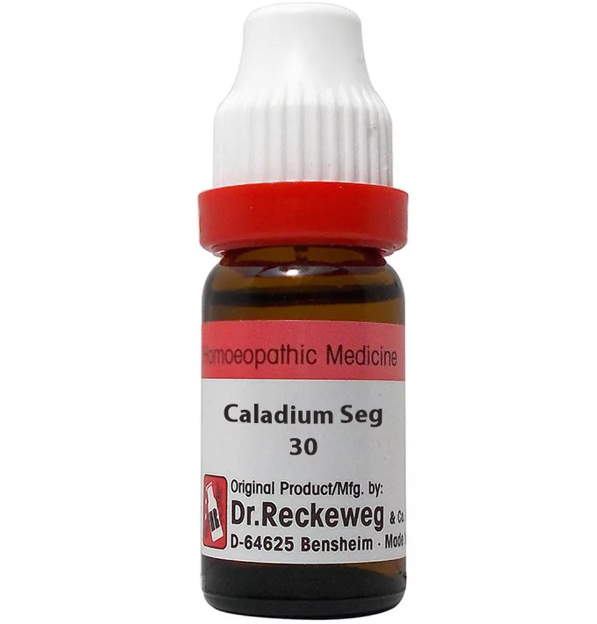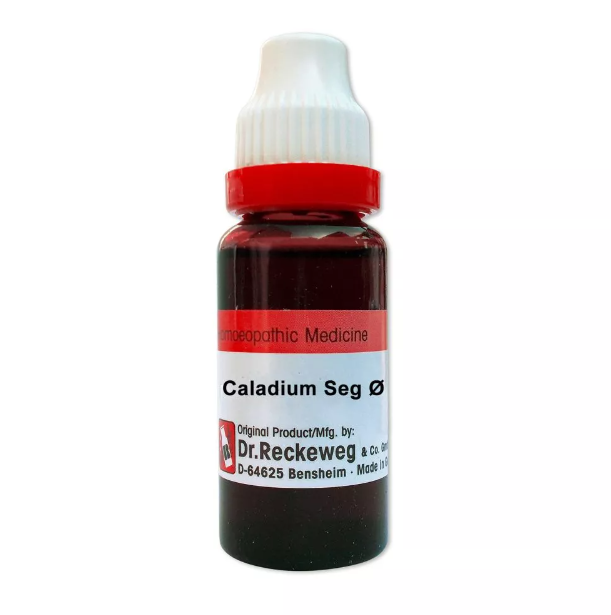CALADIUM SEGUINUM Q, 6C, 12C, 30C, 200C, 1M, 10M USES AND SYMPTOMS
 CALADIUM SEGUINUM
CALADIUM SEGUINUM
(American Arum)
This remedy significantly affects the genital organs and itching in this area. Coldness in specific parts with a tendency to lie down, worsening when lying on the left side. The slightest noise startles from sleep. Aversion to movement. Reduces craving for tobacco. “Tobacco heart” and asthmatic issues.
Head: Headaches and mental states of smokers. Very forgetful, unaware of events. Confused headache with shoulder pain, eye and forehead pressure; extremely noise-sensitive, throbbing in the ears.
Stomach: Gnawing at the stomach’s orifice, hindering deep breathing. Eructations. Stomach feels full of dry food; fluttering sensation. Acrid vomiting, thirstless, tolerates only warm drinks. Sighing respiration.
Male: Itching. Very red glans (balanitis). Organs seem larger, puffed, relaxed, cold sweating; thick scrotum skin. Erections when half asleep; cease when fully awake. Impotence; penis relaxes during excitement. No emission or orgasm during intercourse.
Female: Itching of the vulva (Ambr., Kreos.) and vagina during pregnancy (Hydrogen peroxide 1:12 locally). Excessive sexual desire (nymphomania). Uterine cramping pains at night.
Respiratory: Larynx feels constricted. Breathing difficult. Catarrhal asthma; mucus not easily expelled. Patient fears sleeping.
Skin: Sweet sweat that attracts flies. Insect bites burn and itch intensely. Itchy rash alternates with asthma. Burning sensation and erysipelas-like inflammation.
Modalities: Better after sweating, after daytime sleep. Worse with movement.
Relationship: Incompatible: Arum-t. Complementary: Nit-ac. Compare: Caps., Phos., Caust., Sel., Lyc. Tribulus terrestris (sexual weakness, emissions, prostatic enlargement).
Dose: Third to sixth attenuation.
SYMPTOMS OF CALADIUM SEGUINUM
Head:
Headaches, particularly common in smokers.
Forgetfulness, confusion.
Sensitivity to noise, throbbing in ears.
Stomach:
Gnawing sensation at the stomach orifice hindering deep breathing.
Eructations.
Sensation of fullness with dry food.
Acrid vomiting, preferring warm drinks.
Sighing respiration.
Male:
Erections occurring while half-asleep but ceasing upon full wakefulness.
Impotence, lack of emission/orgasm during intimacy.
Female:
Pruritus of the vulva and vagina, especially during pregnancy.
Voluptuousness (nymphomania).
Uterine cramping at night.
Respiratory:
Catarrhal asthma, difficulty in expelling mucus.
Fear of sleeping.
Skin:
Sweet sweat attracting flies.
Intense burning and itching from insect bites.
Itching rash alternating with asthma.
Burning sensation, erysipelatous inflammation.
Modalities:
Better after sweating, daytime sleep.
Worse with motion.
Relationships:
Incompatible with Arum-t.
Complementary with Nit-ac.
Comparable to Caps., Phos., Caust., Sel., Lyc., Tribulus terrestris.
selection of the potency
Individualization:
- Homeopathy is based on the principle of treating the individual, not just the disease. The unique symptoms and characteristics of the person are crucial in determining the most suitable potency.
Intensity of Symptoms:
- The intensity of the symptoms guides the choice of potency. If the symptoms are intense and acute, a lower potency (e.g., 6C, 30C) might be considered. For chronic conditions with less intensity, higher potencies (e.g., 200C, 1M) may be appropriate.
Sensitivity of the Patient:
- Some individuals are more sensitive to homeopathic remedies, while others may require higher potencies. The practitioner considers the patient’s sensitivity when selecting the potency.
Acute vs. Chronic Conditions:
- Lower potencies are often used for acute conditions, while higher potencies may be considered for chronic or long-standing issues.
Previous Response to Potencies:
- The patient’s response to previous homeopathic treatments helps guide the choice of potency. If a particular potency has been effective in the past, it may be repeated or adjusted as needed.
Vital Force and Susceptibility:
- Homeopathy views illness as a disturbance in the vital force. The practitioner assesses the patient’s overall vitality and susceptibility to determine the appropriate potency.
Aggravation or Amelioration:
- The direction of the symptom response (aggravation or amelioration) after taking a remedy can influence the choice of potency.
Miasmatic Considerations:
- In classical homeopathy, the concept of miasms (inherited disease tendencies) is considered. The practitioner take this into account when selecting the potency.
Practitioner Experience:
- The experience and preference of the homeopathic practitioner play a role. Some practitioners may have success with certain potencies based on their clinical experience.
SAFETY INFORMATION
- Do not exceed the recommended dose by physician
- Keep out of the reach of children
- Store in a cool dry place away from direct sunlight
- Maintain half an hour gap between food/drink/any other medicines and homoeopathic medicine
- Avoid any strong smell in the mouth while taking medicine e.g. camphor, garlic, onion, coffee, hing
Medicine images use for reference only selection of homeopathic medicine depends on the individual’s specific symptoms and overall constitution. Moreover, homeopathy is a holistic system of medicine that treats the individual as a whole. In addition to addressing the physical symptoms, it takes into account the emotional and mental state of the person. Consequently, it’s crucial to consult with a qualified homeopathic practitioner for personalized treatment.
The information provided on this website is intended solely for educational purposes. Always seek the advice of your physician or other qualified health provider.
